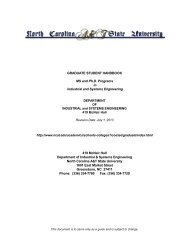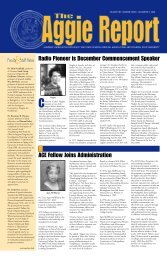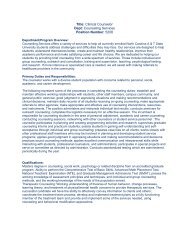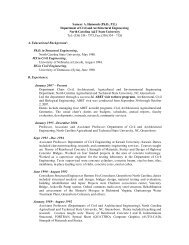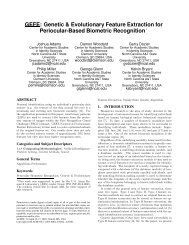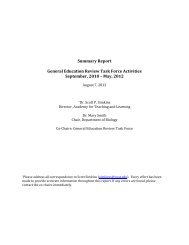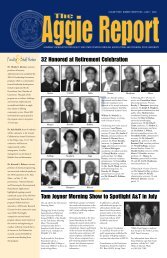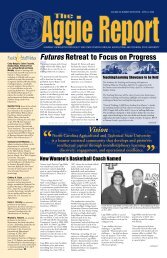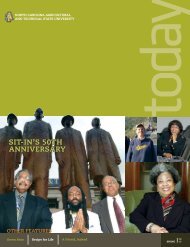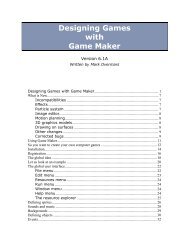Love's Reward - North Carolina A&T State University
Love's Reward - North Carolina A&T State University
Love's Reward - North Carolina A&T State University
You also want an ePaper? Increase the reach of your titles
YUMPU automatically turns print PDFs into web optimized ePapers that Google loves.
Spring<br />
2K<br />
12<br />
inside aggieland<br />
Nano School Facility Opens with Big Expectations<br />
NSF, FDA and A&T Organize<br />
International Workshop<br />
The $64 million Joint School of Nanoscience and Nanoengineering<br />
facility at Gateway <strong>University</strong> Research Park, South Campus, officially<br />
opened in December.<br />
It was five years in the making and one year since the first classes began,<br />
but the new facility that houses the Joint School of Nanoscience and<br />
Nanoengineering (JSNN) at the Gateway <strong>University</strong> Research Park, South<br />
Campus, on East Lee Street was worth the wait.<br />
JSNN is an academic and technical institution created by <strong>North</strong> <strong>Carolina</strong><br />
Agricultural and Technical <strong>State</strong> <strong>University</strong> and The <strong>University</strong> of <strong>North</strong><br />
<strong>Carolina</strong> at Greensboro, with the support of the <strong>North</strong> <strong>Carolina</strong> General<br />
Assembly and technology leaders in the community. One of the few<br />
degree-granting schools in the world focused exclusively on nanoscience<br />
and nanoengineering, JSNN’s objective is to become a world class<br />
educational and research institution, serving as an engine for economic<br />
growth in the Greensboro/Triad area. (Degrees in nanoscience are being<br />
offered by UNCG and nanoengineering by N.C. A&T.)<br />
Gov. Bev Perdue and other<br />
distinguished guests from across<br />
the state and as far away as France<br />
participated in the much anticipated<br />
grand opening Dec. 7, 2011. Ed Kitchen,<br />
chairman of Gateway’s board of<br />
directors presided over the event.<br />
The point that was made repeatedly is<br />
that the collaboration behind the JSNN<br />
is much larger than the building it calls<br />
home. The partnerships between A&T,<br />
UNCG and Gateway with educational<br />
institutions, business and industry<br />
around the world will increase the<br />
universities’ collective credibility of<br />
the Triad as a research community and<br />
enhance the regional, national and<br />
international reputation. It also will<br />
serve as a pipeline for job creation at<br />
the highest level.<br />
According to research conducted by<br />
the National Science Foundation, there<br />
is a projected need for more than two<br />
million nanotechnology savvy workers<br />
by the year 2014. Of those employees,<br />
20 percent are expected to be scientists,<br />
and the remaining 80 percent will<br />
encompass a range from highly skilled<br />
engineers to skilled workers.<br />
Perdue said that because <strong>North</strong><br />
<strong>Carolina</strong> is the epicenter for research<br />
and advancement in nanoscience and<br />
nanoengineering, it is anticipated that<br />
a lot of that job creation will start at<br />
the JSNN and will impact other related<br />
industries as well.<br />
A&T Chancellor Harold L. Martin Sr. said, “The JSNN provides a<br />
great academic and commercial model and will help universities<br />
assume a greater role in partnership with business leaders<br />
throughout the Triad—in making our region more appealing.<br />
By combining our respective strengths, we can ensure the<br />
continued success of preparing outstanding graduates to be<br />
competitive in the professional workforce and also maintain our<br />
standing as a region of economic competitiveness in the areas<br />
of research and development.”<br />
The nanoengineering research program already has generated<br />
almost $4 million in external research funding in its first year<br />
and a half of existence. The work involves a broad range of<br />
areas, including nanotechnology tools for disease diagnostics<br />
and regenerative medicine, components of photonic<br />
nanosystems for sensor/detection systems and other security<br />
applications, and the performance characteristics of materials<br />
such as nanoengineered concrete.<br />
To date, the Army Research Office is a major funder of this<br />
research, which will have both defense and civilian applications.<br />
JSNN also has received a letter of intent from Horiba<br />
Scientific of Chilly-Mazarin, France, one of the world’s largest<br />
manufacturers of analytical and spectroscopic systems and<br />
components dedicated to scientific research.<br />
JSNN is led by Dr. James G. Ryan, who has served at the<br />
Joint School since July 2008. Prior to joining JSNN as the<br />
founding dean, Ryan was an associate vice president of<br />
technology and professor of nanoscience in the College of<br />
Nanoscale Science and Engineering of the <strong>University</strong> at Albany,<br />
one of the world’s leading colleges of nanotechnology. He<br />
served as principal or co-principal investigator for contracts<br />
totaling more than $1.7 billion while at CNSE.<br />
The National Science Foundation and the Food and<br />
Drug Administration teamed up with N.C. A&T<br />
and Germany’s Hannover Medical School to hold a<br />
daylong public workshop on the emerging field of<br />
biodegradable metals.<br />
“<strong>State</strong> of the Art in Biodegradable Metals: A Think-<br />
Tank Workshop” was held Friday, March 30, at the<br />
FDA’s White Oak campus in Silver Spring, Md., drew<br />
researchers from around the world.<br />
According to Dr. Jagannathan Sankar, director of the<br />
NSF Engineering Research Center for Revolutionizing<br />
Metallic Biomaterials at A&T, the conference provided<br />
a unique opportunity for global experts in the field of<br />
biodegradable metals to come together to review the<br />
current status of the field, to identify key challenges<br />
remaining, and to explore opportunities to meet<br />
those challenges through collaboration. “We hope<br />
this session (was) the first of many that will help<br />
accelerate access to this technology, which promises<br />
better outcomes for patients,” said Sankar.<br />
Biodegradable metal implants have potential in<br />
certain types of surgery, including orthopedic,<br />
craniofacial and cardiovascular, through the use of<br />
devices that safely degrade once they are no longer<br />
needed. This could eliminate the need for surgical<br />
removal of devices.<br />
The conference covered the breadth of current<br />
knowledge in the field, especially regarding<br />
magnesium-based systems such as those being<br />
developed by the ERC. Hannover is an ERC research<br />
partner, as are the <strong>University</strong> of Pittsburgh and the<br />
<strong>University</strong> of Cincinnati.<br />
Workshop presenters included a select group of<br />
global experts from academia, large industries, small<br />
entrepreneurial networks, and the FDA.<br />
Visit us online at www.ncat.edu<br />
2 | today today | 3



